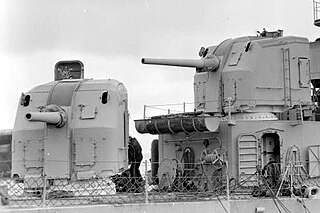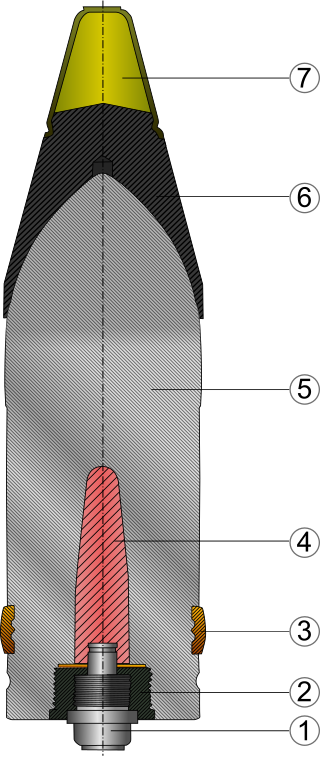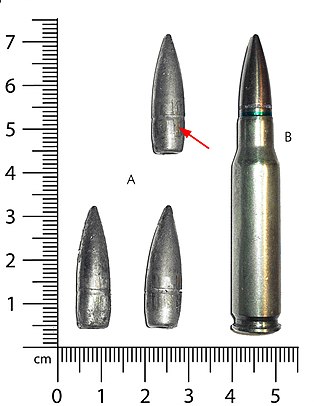
Armour-piercing ammunition (AP) is a type of projectile designed to penetrate armour protection, most often including naval armour, body armour, and vehicle armour.

The 8.8 cm KwK 36 was an 88-millimetre (3.5 in) tank gun used by the German Army during World War II. This was the primary armament of the PzKpfw VI Tiger I tank. It was developed and built by Krupp.

The 8.8 cm KwK 43 was an 88 mm 71-calibre-length tank gun designed by Krupp and used by the German Wehrmacht during the Second World War. It was mounted as the primary armament on the Panzerkampfwagen VI Ausf. B Tiger II. The 8.8 cm Pak 43, an anti-tank gun, was very similar in design but mounted on tank destroyers or deployed stand-alone on the field.

A shell, in a military context, is a projectile whose payload contains an explosive, incendiary, or other chemical filling. Originally it was called a bombshell, but "shell" has come to be unambiguous in a military context. A shell can hold a tracer.

The 75 mm gun, models M2 to M6, was the standard American medium caliber gun fitted to mobile platforms during World War II. They were primarily mounted on tanks, such as the M3 Lee and M4 Sherman, but one variant was also used as an air-to-ground gun on the B-25 Mitchell medium bomber aircraft. There were five main variants used during the war: M2, M3, M4, M5 and M6.

The Type 11 70 mm infantry mortar, was a muzzle-loading, rifled bore infantry mortar used by the Japanese. The Type 11 designation was given to this gun as it was accepted in the 11th year of Emperor Taishō's reign (1922). It was first used in 1922 and was the first mortar to be introduced by the Imperial Japanese Army. The Type 11 was later replaced by the Type 92 battalion gun.
20 mm caliber is a specific size of popular autocannon ammunition. The dividing line between smaller-caliber weapons, commonly called "guns", from larger-caliber "cannons", is conventionally taken to be the 20 mm round, the smallest caliber of autocannon. All 20 mm cartridges have an outside projectile (bullet) diameter and barrel bore diameter of approximately 0.787 inches (20.0 mm). These projectiles are typically 75 to 127 mm (3–5 in) long, cartridge cases are typically 75 to 152 mm (3–6 in) long, and most are shells, with an explosive payload and detonating fuze.

The Ordnance QF 75 mm, abbreviated to OQF 75 mm, was a British tank gun of the Second World War. It was obtained by boring out the Ordnance QF 6-pounder 57 mm anti-tank gun to 75 mm, to give better performance against infantry targets similarly to the 75 mm M3 gun fitted to the American Sherman tank. The QF came from "quick-firing", referring to the use of ammunition where the shell has a fixed cartridge. The gun was also sometimes known as ROQF from Royal Ordnance Quick-Firing.

The Mark 12 5"/38-caliber gun was a United States dual-purpose naval gun, but also installed in single-purpose mounts on a handful of ships. The 38-caliber barrel was a mid-length compromise between the previous United States standard 5"/51 low-angle gun and 5"/25 anti-aircraft gun. United States naval gun terminology indicates the gun fired a projectile 5 inches (127 mm) in diameter, and the barrel was 38 calibers long. The increased barrel length provided greatly improved performance in both anti-aircraft and anti-surface roles compared to the 5"/25 gun. However, except for the barrel length and the use of semi-fixed ammunition, the 5"/38 gun was derived from the 5"/25 gun. Both weapons had power ramming, which enabled rapid fire at high angles against aircraft. The 5"/38 entered service on USS Farragut, commissioned in 1934, the first new destroyer design since the last Clemson was built in 1922. The base ring mount, which improved the effective rate of fire, entered service on USS Porter, commissioned in 1936.

The 76 mm gun M1 was an American World War II–era tank gun developed by the U.S United States Ordnance Department in 1942 to supplement the 75 mm gun on the basic Medium tank M4. It was also used to arm the M18 Hellcat tank destroyer.

The 7.5 cm KwK 40 was a German 75 mm Second World War era vehicle-mounted gun, used as the primary armament of the German Panzer IV medium tank and the Sturmgeschütz III and Sturmgeschütz IV assault guns which were used as tank destroyers.

The Panzergranate 39 or Pzgr. 39 was a German armor-piercing shell used during World War II. It was manufactured in various calibers and was the most common anti-tank shell used in German tank and anti-tank guns of 37 to 88 mm caliber.
The 37 mm Automatic Gun, M4, known as the T9 during development, was a 37 mm (1.46 in) recoil-operated autocannon designed by Browning Arms Company and entered service in 1942. The M4 and its variants would primarily be manufactured by Colt's Manufacturing Company and Oldsmobile and is therefore sometimes referred to as the "Colt M4" or "Oldsmobile M4." It was primarily mounted in the Bell P-39 Airacobra and P-63 Kingcobra, with the U.S. Navy also utilizing it on many PT boats.

The 6-inch/47-caliber Mark 16 gun was used in the main batteries of several pre-war and World War II US Navy light cruisers. They were primarily mounted in triple turrets and used against surface targets. The Mark 16DP gun was a dual-purpose fitting of the Mark 16 for use against aircraft as well as surface ships. It was installed in the postwar Worcester-class light cruisers and the anti-aircraft gunnery training ship Mississippi.

Ammunition is the material fired, scattered, dropped, or detonated from any weapon or weapon system. Ammunition is both expendable weapons and the component parts of other weapons that create the effect on a target.

The 7.62×51mm NATO is a rimless, straight walled, bottlenecked rifle cartridge. It is a standard for small arms among NATO countries.

The Gryazev-Shipunov GSh-30-1 is a 30 mm autocannon designed for use on Soviet and later Russian military aircraft, entering service in the early 1980s. Its current manufacturer is the Russian company JSC Izhmash. The name GSH-30-1 is formed from the surnames of the designers Gryazev (Грязев) and Shipunov (Шипунов), the caliber of 30 mm and the single-barrel design of the gun itself.

The 155mm L/40 T7 was an American rifled tank gun developed in 1945. The T7 was to be the main armament for the T30 Heavy Tank, but only a handful were produced due to the T30 project being cancelled after trials in the late 1940s.

The XM913 is an experimental American chain gun produced at Picatinny Arsenal. The cannon is a larger and more modern version of the 35 mm Bushmaster III chain gun, which itself is a larger version of the 25 mm M242 Bushmaster cannon. Although its shells, 50 x 228 mm, are twice the diameter of the 25×137mm cartridge of the M242, the 50mm cannon is not much longer than the smaller weapon. The overall lengths of the 25mm cannon and 50mm cannon are 105.2 inches (267 cm) and 117.7 inches (299 cm), respectively; while the portion of the gun that intrudes into the turret are 30.0 inches (76 cm) and 40.1 inches (102 cm), respectively.

















